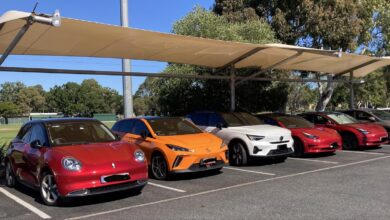Rivian launches new R1T and R1S, the next-generation of its flagship EVs

Rivian has officially launched the next-generation R1S and R1T, new versions of the company’s flagship electric vehicles.
“We continue to evolve our flagship R1 vehicles,” CEO RJ Scaringe said, “offering quality and performance without compromise. Our revamped R1S and R1T push the technical boundaries further, creating our most capable products to date.”
Rivian aimed to refine and improve performance, design, range, and overall ownership experience with the new R1T and R1S, bringing everything from new drivetrains to new interior aesthetics to the EVs without compromising any of the features that owners loved about the first generation.
Additionally, Rivian is rolling out its new Autonomy Platform, which was developed in-house and utilizes eleven internally developed cameras along with five radars that perform over 250 trillion operations per second.
“For most owners, their R1 Gen 2 will be the most powerful computer that they own,” VP of Autonomy and AI for Rivian, James Philbin, said.
Let’s dive into some of the improvements Rivian has employed:
Performance
Rivian’s next-gen R1 platform now features more power, performance, and range, all stemming from a new drive unit offered in its Tri and Quad-Motor configurations. Dual-Motor has not gone anywhere either, and still offers great performance metrics:
- Dual-Motor Our Dual-Motor delivers incredible all-wheel drive capability along with 665 horsepower and 0–60 mph in as quick as 3.4 seconds for the Performance variant
- Tri-Motor Our all-new 850 horsepower Tri-Motor packs two motors in the rear and one in front for a blend of exceptional power and range. The Tri-Motor R1T delivers 0–60 mph in 2.9 seconds while offering an estimated range of 380 miles. In Conserve Mode, the estimated range is up to 410 miles.
- Quad-Motor For peak adventure, our new 1,025 horsepower Quad-Motor delivers 0–60 mph in less than 2.5 seconds in R1T — and ¼ mile in 10.5 seconds — with a staggering 1,198 lb-ft of torque when using Launch Mode. 60–80 mph acceleration is 1.5 seconds, with incredible torque control at each wheel for superior on-road performance and off-road capability.
Ride and Handling
Rivian also focused on the ride and handling experience in the R1 lineup for this second-generation vehicle launch. The suspension system has been fully re-engineered, improving on what customers called a “sport-tuned feel” in the first-generation EVs. Rivian decided to go with a “smoother” ride for the new R1T and R1S, which is adjustable to ensure comfortable on and off-road capabilities.
Vehicle equipment has also been refined. Rivian developed new wheels and fitted them with new tires, including a redesigned 22″ aerodynamic wheel design and Pirelli-developed tires to increase range.
For Performance, Rivian is going with an Ultra-High-Performance Michelin tire that will be available on the Quad-Motor configurations. Additionally, for a “well-rounded” experience, Goodyear has a 20″ ADV tire that offers “balanced all-around capability with the rolling-resistance of an all-season,” and comes standard.
Range and Batteries
Three battery pack sizes will still be offered by Rivian, but the Max and Large batteries have been completely re-engineered and offer ranges of 420 and 330 miles, respectively, based on estimations. They will continue to use 2170 cylindrical cells, and the pack enclosure features a “large high-pressure de-casting” system to simplify manufacturing and reduce mass.
The new Standard Pack will feature lithium-iron-phosphate (LFP) chemistry and provide an EPA-estimated 270-mile range.
140 miles of range can be regained in as little as 20 minutes and are compatible with all major public high-speed charging networks. This includes the Rivian Adventure Network and the Tesla Supercharger Network.
Design and Experience
Rivian honed in on new features with the R1T and R1S and also added two new premium interiors, new exterior paint options, and new darkout trim options.
These are in addition to the new wheel and tire choices, and now vehicles come with a new electronically tinted glass roof, new in-cabin storage, interior lighting themes, new digital interfaces, and new cell shading designs for the different drive modes. It has also improved on the wireless charger.
Surround Sound Audio with Dolby Atmos is available with Rivian Premium Audio.
Refined Electrical Architecture and Compute Platform
The second-gen R1 features new electrical architecture and a new compute platform that was developed in-house by the Rivian hardware and software teams.
“While the exterior of the R1 looks similar, the electrical system is completely redone, providing a significant increase in features as well as a dramatic increase in sensing and compute capability,” Rivian’s SVP of Electrical Hardware, Vidya Rajagopalan, said.
Trimming the ECU count from 17 in the first-gen to just 7 in the second-gen, the “massive simplification” was part of a shift in zonal architecture. Infotainment, autonomy, and vehicle access, as well as battery management, all have their own ECUs. Every other vehicle function is controlled by the remaining three.
Rivian Autonomy Platform
The Rivian Autonomy Platform utilizes “11 internally developed cameras and five radars performing over 250 trillion operations per second, an industry-leading level of compute power.”
The cameras are high-resolution and now include 4K HDR units, which have 360-degree visibility and can see three-times farther than the previous system, as well as 10 seconds ahead at highway speeds.
These are the most camera megapixels of any EV in North America and enable improved dynamic range and clear vision in high-contrast scenarios, like tunnel entrances and exits.
Rivian is also utilizing a cabin-facing camera in the rearview mirror to detect both driver fatigue and distraction when operating in Enhance Highway Assist mode, which will roll out later this year.
The Autonomy Compute Module is backed up by dual NVIDIA DRIVE Orin processors, delivering 10 times more compute performance than the previous system.
Pricing
The new R1S will start at $75,900 and the R1T at $69,900. Dual-Motor configurations can be ordered today and are available immediately. Tri-Max is expected to be launched in the late Summer, while Quad Max will come shortly after.
I’d love to hear from you! If you have any comments, concerns, or questions, please email me at joey@teslarati.com. You can also reach me on Twitter @KlenderJoey, or if you have news tips, you can email us at tips@teslarati.com.



